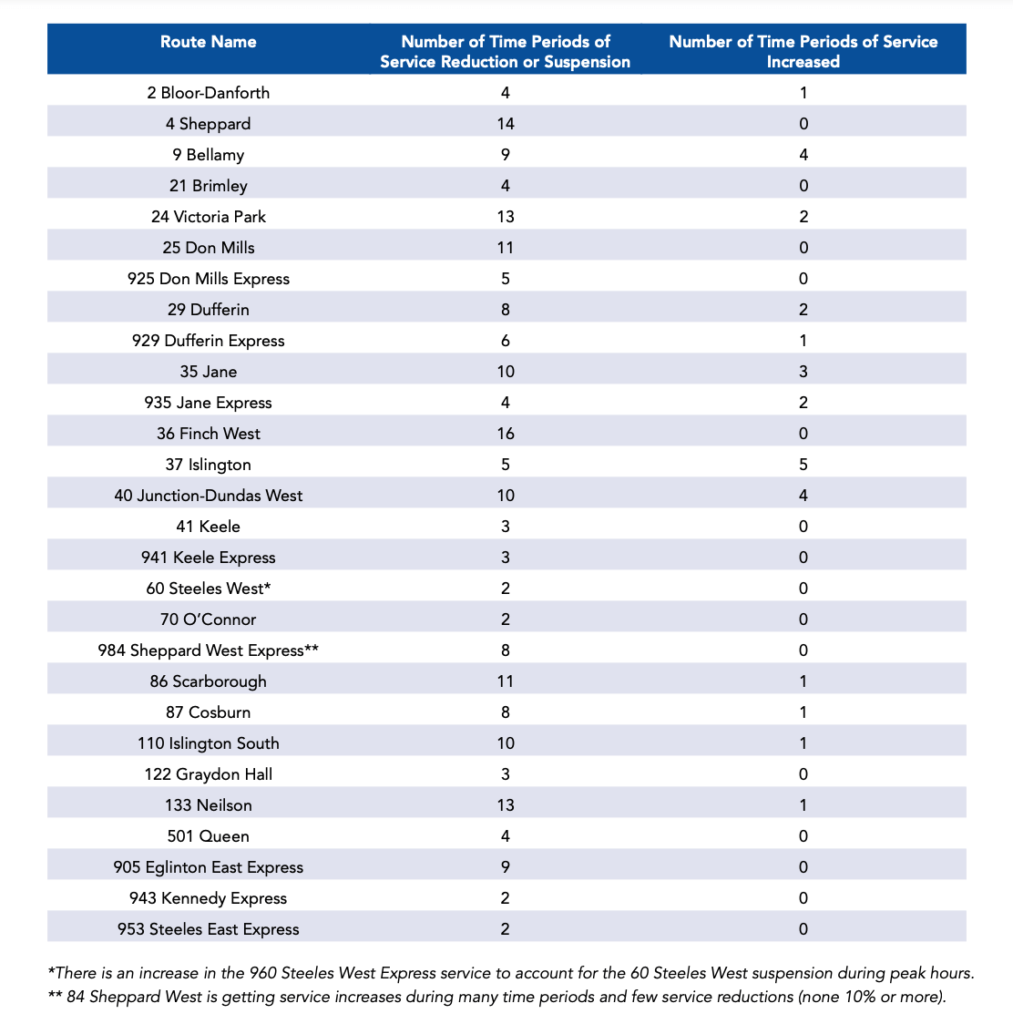
Researchers at Toronto Metropolitan University (TMU) have found that the TTC’s service cuts set to take effect on Sunday will disproportionately impact marginalized communities in Toronto.
The new study, led by TMU authors Dr. Raktim Mitra and Tess Peterman, discovered that the
Toronto Transit Commission (TTC) service changes, which involve a reduction in service for 20 per cent of all TTC routes, will run through areas where a greater number of marginalized people live.
MARGINALIZED COMMUNITIES IMPACTED BY SERVICE CUTS
A total of 39 routes will be seeing several service adjustments. This includes 37 daytime buses, one streetcar route, and two subway routes.

The report states 26 of the 28 routes that will experience at least a ten per cent increase in wait times will go through or connect to a neighbourhood with high material deprivation. This means areas of higher poverty, a concentration of ethnic groups, and unemployment rates.
READ MORE: TTC fares rising in April for adults and youths

Additionally, 79 per cent of TTC routes that will experience at least a ten per cent increase in wait times will connect to a neighbourhood with high level dependency. This involves suburban neighbourhoods located in the northeast and western parts of the city, which already experience poor transit accessibility.

TRANSIT NEEDS TO BE ‘FREQUENT AND RELIABLE’
In an interview with Now Toronto, Mitra says most marginalized groups, such as lower income new immigrants or various ethnic groups,tend to live further downtown towards the edges of the city in areas like Scarborough, North York and Northwest Etobicoke. These areas already had poor public transportation service, in comparison to the downtown core which is fairly well serviced.
“Our suburban communities were disadvantaged to begin with. They have buses that run in some extent and have very long headways between two buses, oftentimes they are not as reliable,” Mitra said.
He explains people who live in suburban areas have to rely on public transit because some cannot afford to live downtown. This is why it’s vital for public transportation to be frequent and reliable, or it will create more barriers to mobility for members of the community who depend on it most.
“Further reduction in service will certainly add an additional barrier for these people to participate in employment, other social activities and entertainment, affecting of course, their well-being,” Mitra said.
Another key point istransit frequency is most effective during the morning and afternoon peak hours, but many people who live in lower income communities don’t necessarily work a nine to five job. That is why consistent public transportation service is critical outside of the traditional peak hours of service.
“The idea is that when we have increased wait time on transit and when the transit is less reliable, it takes more time to get to work, it takes more time to get to social activities, it takes more time to visit family and it takes more time to go to a grocery store,” Mitra explained.
He adds there are two effects to these TTC service changes. The first is that transit will become more inconvenient for people and they will turn to other modes of transportation, such as driving, which is not ideal from an environmental and economic perspective.
TTC NEEDS TO FIND MORE REVENUE SOURCES
Mitra said he, along with his co-authors, recognize the position the TTC is in. He acknowledged that the transit agency needed to address its budget shortfalls and fund its upcoming improvement plans. However, Mitra’s hope was that the funding would not stem from service cuts, but by finding new lines of revenue.
“We cannot improve public transportation by cutting transportation services, it’s just counterintuitive. Doesn’t make any sense. So realistically, I think in the long term, our hope is that this cut should be short-lived,” Mitra said. “Once you’ve cut public transit, ridership would go down and then it would create another rationale to cut services further,” he continued.
With all things considered, researchers believe this decision by the TTC is only going to create more problems than solutions. In fact, the TTC has still not recovered from low ridership levels originating from the pandemic.
The TTC’s strategy to implement service reductions is part of Phase 1 of its 2023 Service Alignment plan. It’s set to begin on Mar. 26, just days prior to the increase in TTC fares for youths and adults rolling out on Apr. 1.












